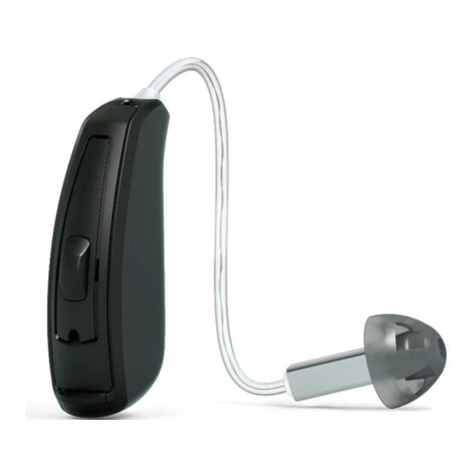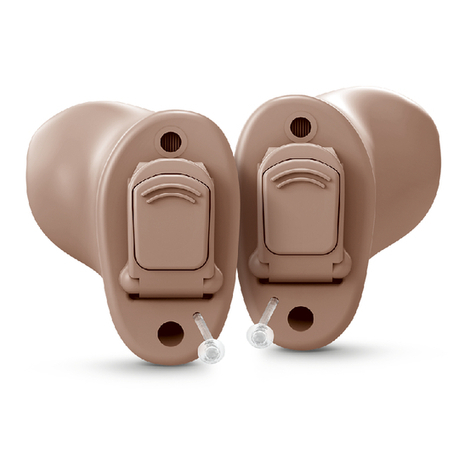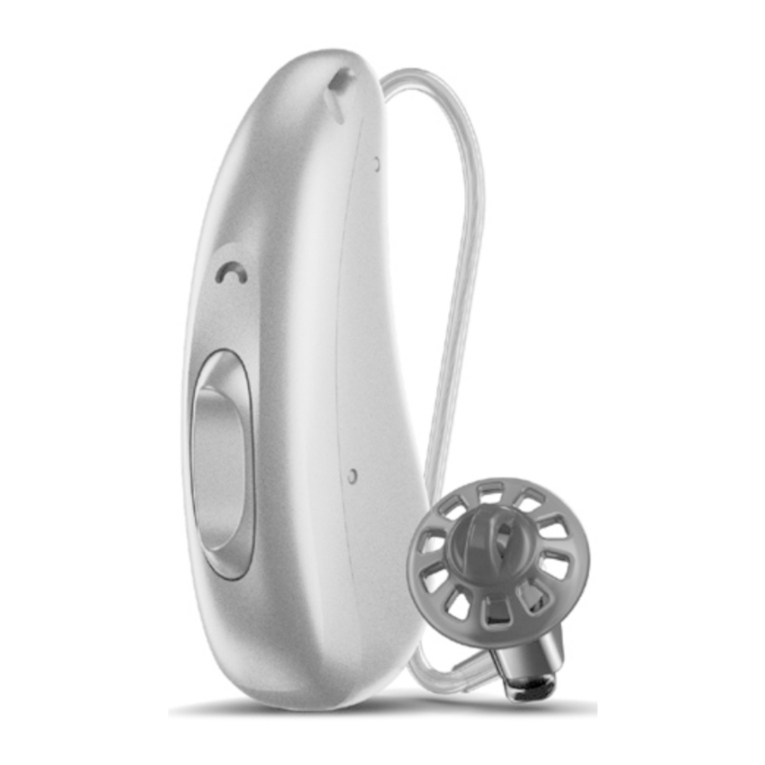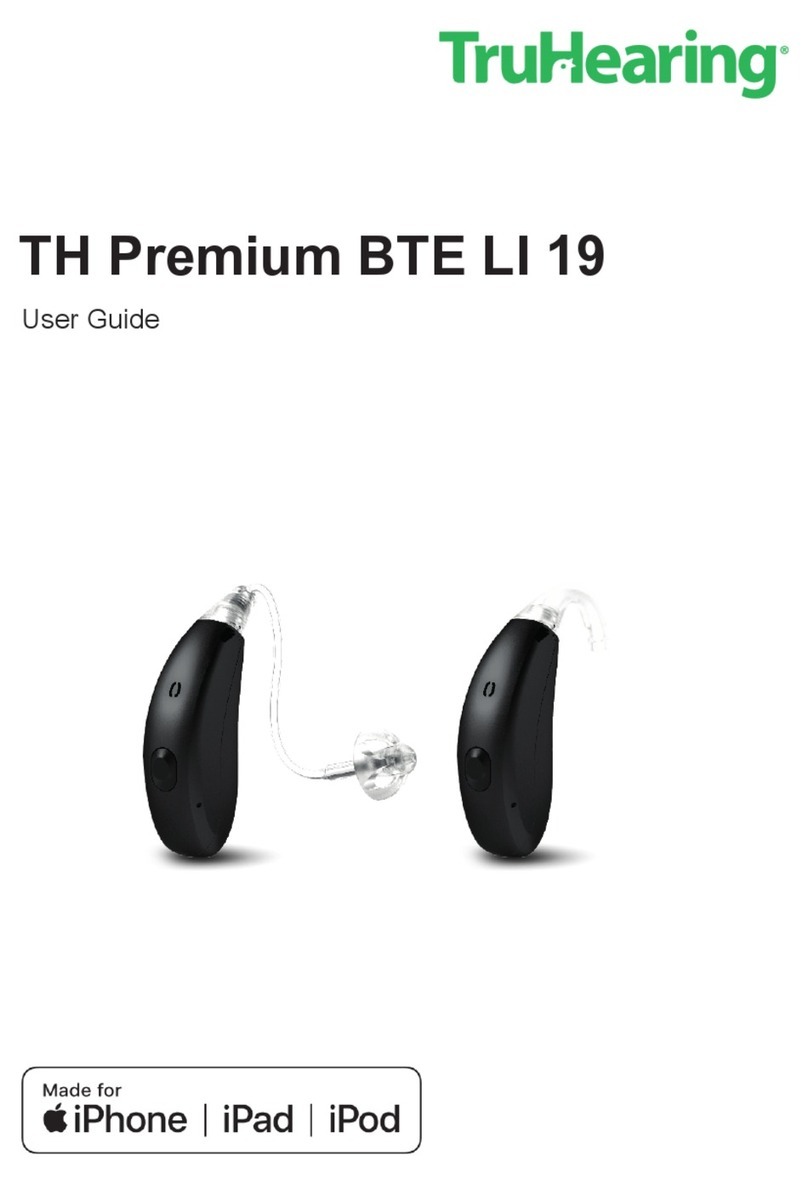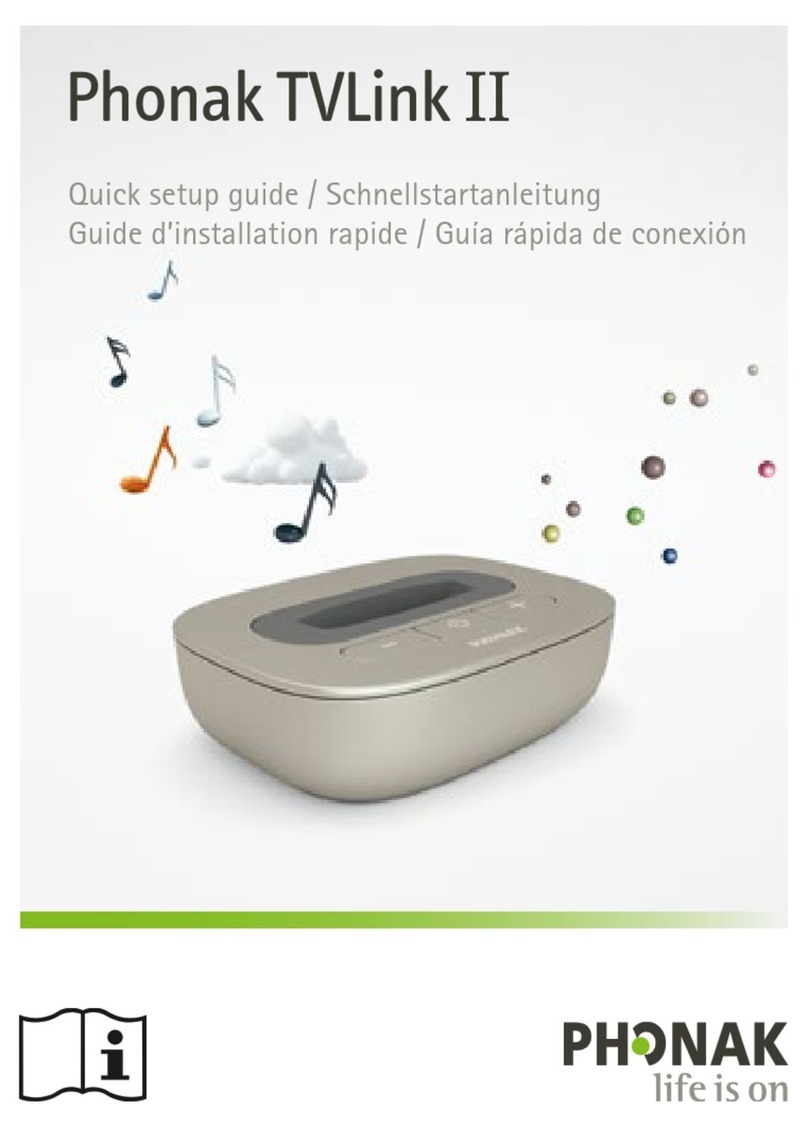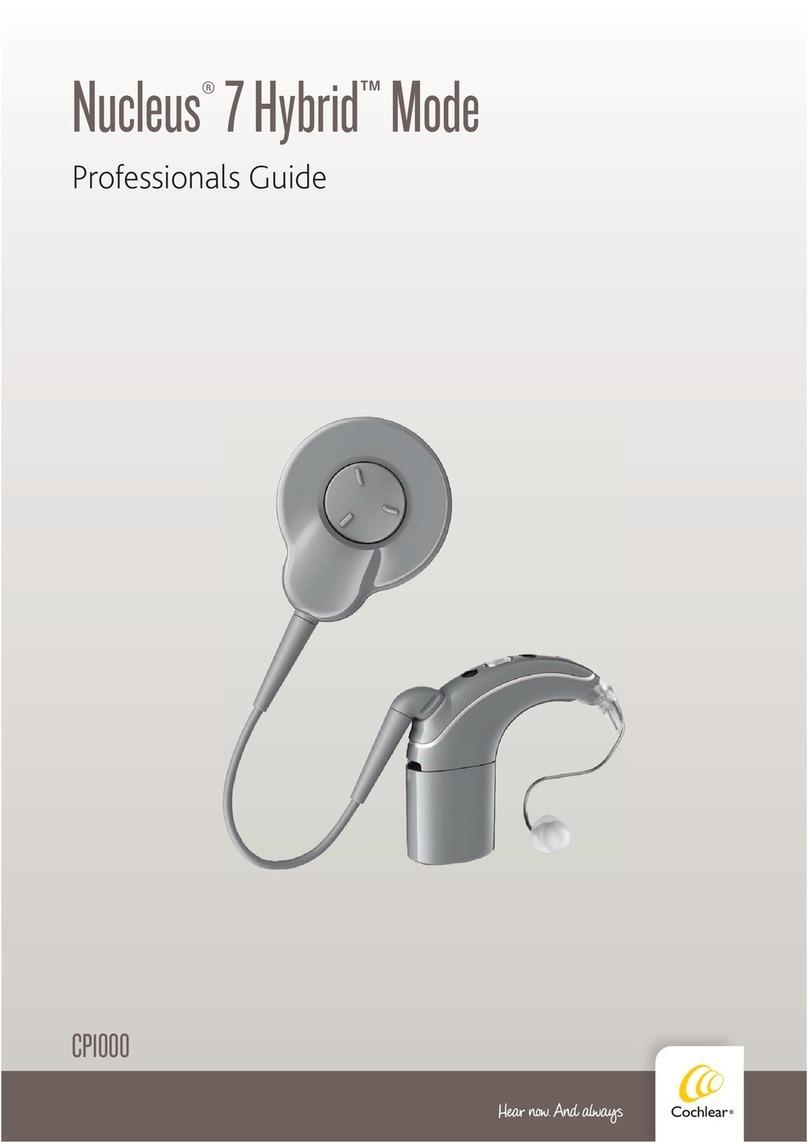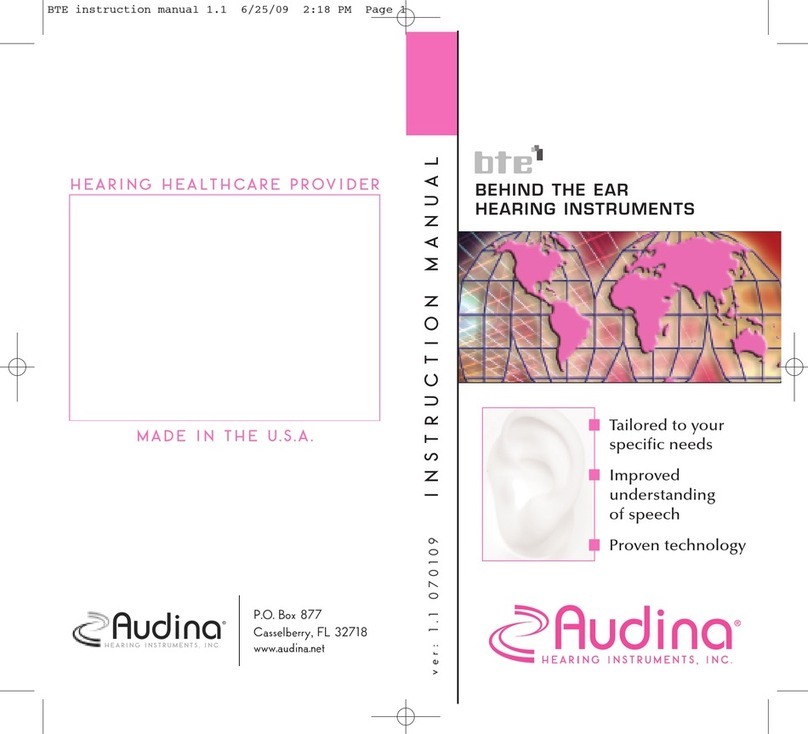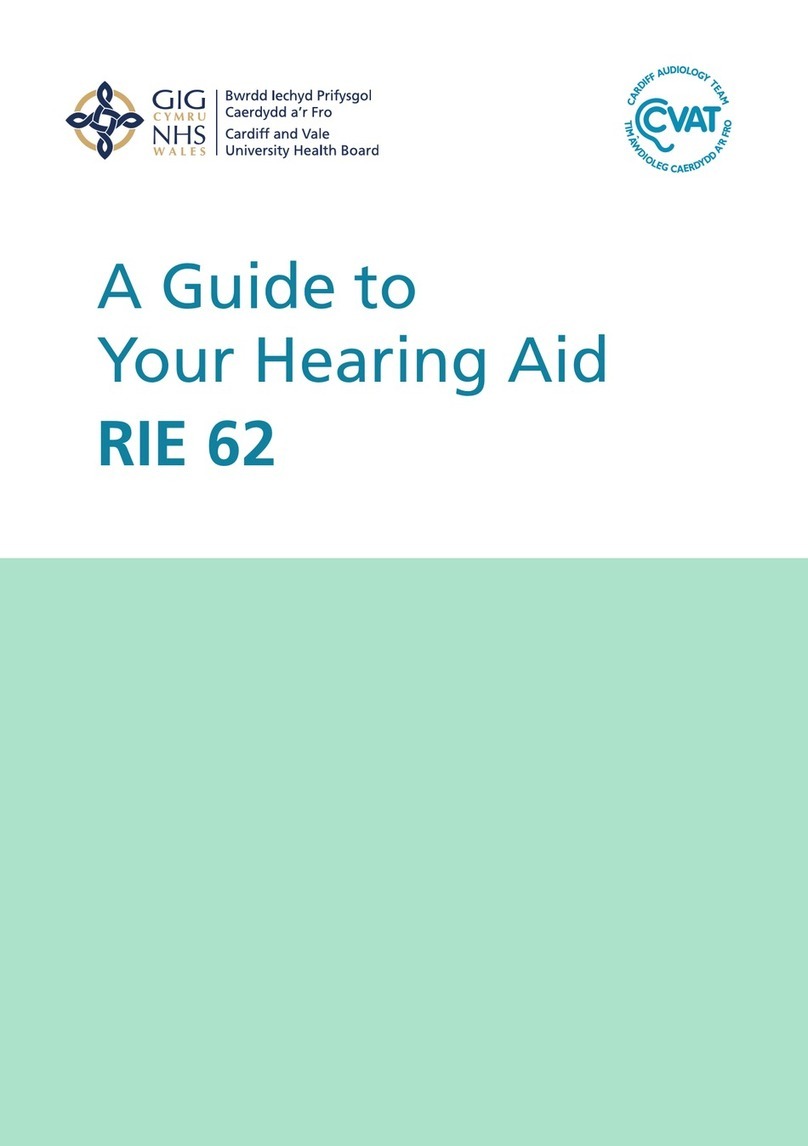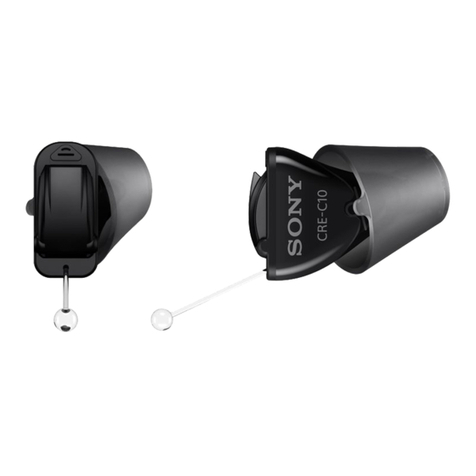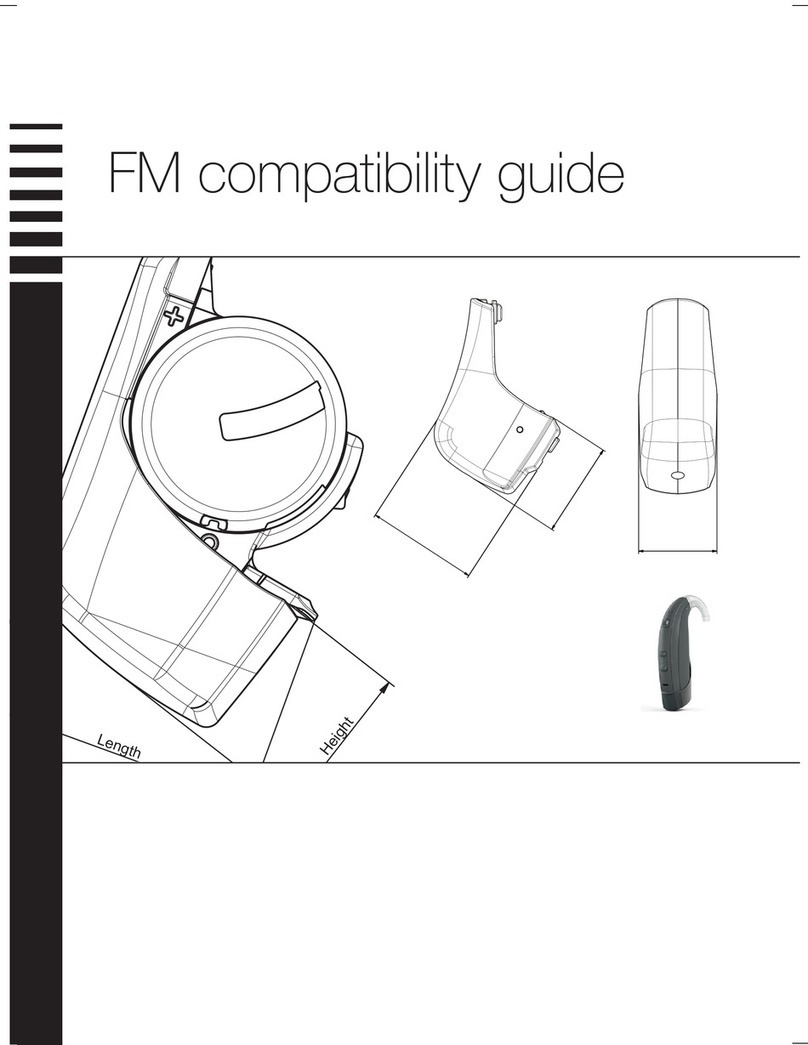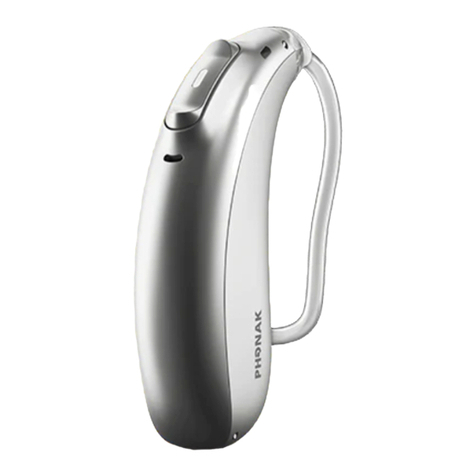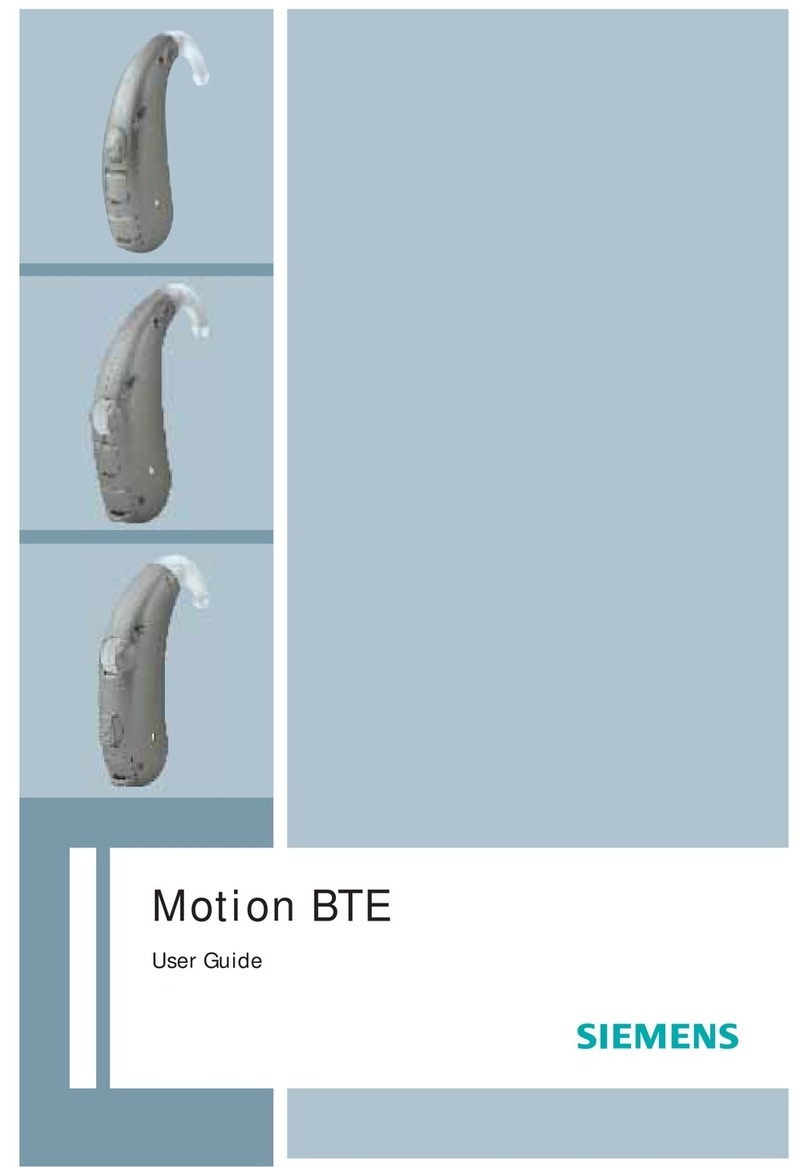GN Hearing Flyte DA312r User manual

User Guide Flyte Custom
User Guide Flyte BTE
User Guide Flyte BTE
User Guide Flyte BTE
400847011US-17.10-Rev.A 1 02-10-2017 14:14:51

2
Hearing instrument type designations for models included in this user guide are: DA312r, FCC ID:
X26DA312r, IC: 6941C-DA312r; DA13r, FCC ID: X26DA13r, IC: 6941C-DA13r; DA312i, FCC ID: X26DA312i,
IC: 6941C-DA312i; and DA13i, FCC ID: X26DA13i, IC: 6941C-DA13i. Please see page 10, 12 and 14 for lists
of models referring to these types.
Statement:
This device complies with part 15 of the FCC rules and ICES-003 of the ISED rules. Operation is subject to
the following two conditions:
(1) this device may not cause harmful interference, and
(2) this device must accept any interference received, including interference that may cause undesired
operation.
Note: This equipment has been tested and found to comply with the limits for a Class B digital device, pur-
suant to part 15 of the FCC Rules and ICES-003 of the ISED rules. These limits are designed to provide rea-
sonable protection against harmful interference in a residential installation. This equipment generates, uses
and can radiate radio frequency energy and, if not installed and used in accordance with the instructions,
may cause harmful interference to radio communications. However, there is no guarantee that interference
will not occur in a particular installation. If this equipment does cause harmful interference to radio or televi-
sion reception, which can be determined by turning the equipment off and on, the user is encouraged to try
to correct the interference by one or more of the following measures:
• Reorient or relocate the receiving antenna.
• Increase the separation between the equipment and receiver.
• Connect the equipment into an outlet on a circuit different from the one in which the receiver is con-
nected.
• Consult the dealer or an experienced radio/TV technician for help.
• Changes or modifications can void the user´s authority to operate the equipment.
400847011US-17.10-Rev.A 2 02-10-2017 14:14:51

3
The products are in compliance with the following regulatory requirements:
• In the EU: the device conforms to the Essential Requirements according to Annex I of Council Directive
93/42/EEC for medical devices (MDD) and essential requirements and other relevant provisions of Direc-
tive 2014/53/EU (RED).
• The declaration of conformity may be consulted at www.resound.com
• In US: FCC CFR 47 Part 15, subpart C.
• Other identified applicable international regulatory requirements in countries outside the EU and US.
Please refer to local country requirements for these areas.
• In Canada: these hearing instruments are certified under the rules of ISED.
• Japanese Radio Law and Japanese Telecommunications Business Law Compliance. This device is
granted pursuant to the Japanese Radio Law (電波法) and the Japanese telecommunications Business
Law (電気通信事業法) This device should not be modified (otherwise the granted designation number
will become invalid).
This device operates in the frequency range of 2.4 GHz - 2.48 GHz.
This device includes an RF transmitter that operates in the range of 2.4 GHz - 2.48 GHz.
Maximum RF output power transmitted is up to 0 dBm.
Intended use
Generic air-conduction hearing instruments are wearable sound-amplifying devices intended to compen-
sate for impaired hearing. The fundamental operating principle of hearing instruments is to receive, amplify,
and transfer sound to the ear drum of a hearing impaired person.
400847011US-17.10-Rev.A 3 02-10-2017 14:14:51

4
Prescription use of a Tinnitus Sound Generator (TSG) hearing
instrument
The TSG module should be used as prescribed by your doctor, audiologist or hearing healthcare profes-
sional.
In order to avoid permanent hearing damages, the maximum daily usage depends on the level of the
generated sound. Should you develop any side effects from using the sound generator, such as dizziness,
nausea, headaches, perceived decrease in auditory function or increase in tinnitus perception, you should
discontinue use of the sound generator and seek medical evaluation.
The target population is primarily the adult population over 18 years of age. This product may also be used
with children 5 years of age or older. However, children and physically or mentally challenged users will re-
quire training by a doctor, audiologist, hearing healthcare professional or the guardian for the insertion and
removal of the hearing instrument containing the TSG module.
Important notice for prospective sound generator users
A tinnitus masker is an electronic device intended to generate noise of sufficient intensity and bandwidth to
mask internal noises. It is also used as an aid in hearing external noises and speech.
Good health practice requires that a person with a tinnitus condition have a medical evaluation by a licensed
physician (preferably a physician who specializes in diseases of the ear) before using a sound generator.
Licensed physicians who specialize in diseases of the ear are often referred to as otolaryngologists, otolo-
gists or otorhinolaryngologists.
400847011US-17.10-Rev.A 4 02-10-2017 14:14:51

5
The purpose of medical evaluation is to assure that all medically treatable conditions that may affect tinnitus
are identified and treated before the sound generator instrument is used.
The sound generator instrument is a tool to generate sounds to be used with appropriate counselling and/
or in a tinnitus management programme to relieve patients suffering from tinnitus.
400847011US-17.10-Rev.A 5 02-10-2017 14:14:51

6
Introduction
Congratulations on the purchase of your new hearing instruments. The innovative sound technology and
design, combined with the customised device programming selected by your hearing care professional, will
make hearing a more enjoyable experience. Hearing instruments will enable you to hear sounds that you
may not have heard in years because of your hearing loss. Practice and a positive attitude are important
in learning to use hearing instruments. Your instruments have been adjusted according to your individual
hearing loss and needs. Some people adjust quickly to wearing hearing instruments in their ears and hear-
ing new sounds; other people may need more time.
This product is a custom-made device.
Please read this manual carefully in order to wholly benefit from the use of your hearing instruments. With
proper care, maintenance, and usage, your hearing instruments will aid you in better communication for
many years. Ask your hearing care professional if you have any questions.
400847011US-17.10-Rev.A 6 02-10-2017 14:14:51

7
Hearing instrument model:
Model CIC: Battery size 10
Model IIC: Battery size 10
Model ITC: Battery size 13 or 312 (circle one)
Model ITE: Battery size 13 or 312 (circle one)
Model MIH: Battery size 13, 312, or 10 for MIH-S (circle one)
Left serial number:
Right serial number:
400847011US-17.10-Rev.A 7 02-10-2017 14:14:51

8
Contents
Statment ... ............................2
Intended use.... .........................3
Prescription use of a Tinnitus Sound
Generator (TSG) hearing instrument.. ........4
Important notice for prospective sound
generator users.........................4
Introduction............................6
Contents ..............................8
Getting started ........................16
On/Off function ........................16
SmartStart ...........................16
Inserting/Replacing the battery............17
Low battery indicator ...................18
Low battery indicator when paired with
wireless accessories only ................18
Inserting/removing hearing instruments .....19
Operation of the hearing instrument . . . . . . . . 22
Volume control (optional).................20
Program button (optional) ................21
Flight mode...........................24
Telephone use.........................25
Telecoil ..............................25
Listen to radio or TV ....................26
Using hearing instruments with smart
phone apps ..........................26
Using hearing instruments with iPhone®,
iPad®, and iPod touch®....................26
Cellular phones .......................27
PhoneNow ...........................27
Tele-loop systems......................29
Care and maintenance ..................29
Daily maintenance......................30
Replacing wax filters ....................30
General precautions ....................31
General warnings ......................32
Tinnitus Sound Generator (TSG) module ....34
Intended use for the TSG module ..........34
User instructions for the TSG module .......34
Using TSG with smart phone apps .........36
The scientific concepts that form the basis
for the device .........................36
Technical Specifications .................37
400847011US-17.10-Rev.A 8 02-10-2017 14:14:51

9
TSG warnings .........................38
TSG precautions.......................38
TSG warning to hearing healthcare
professionals..........................39
Battery warning information ..............40
Hearing instrument expectations. ..........41
Warning to hearing aid dispensers .........42
Important notice for prospective
hearing aid users ......................42
Children with hearing loss................43
Troubleshooting guide ..................44
Technical data.........................48
Warranty and repairs....................49
Temperature test, transport and
storage information .....................49
400847011US-17.10-Rev.A 9 02-10-2017 14:14:52

10
Mic in Helix (MIH-S) hearing instrument models
with size 10A battery are available in the following
variants:
FL9MIH-S-UP, FL9MIH-S-HP, FL9MIH-S-MP,
FL9MIH-S-LP
Mic in Helix (MIH) hearing instruments
(including type DA312r with FCC ID X26DA312r,
IC number 6941C-DA312r models designated by
a “W”) with size 312 battery and Custom Mic in
Helix hearing instruments (including type DA13r
with FCC ID X26DA13r, IC number 6941C-DA13r
models designated by a “W”) with size 13 battery
are available in the following variants:
FL9MIH-W-UP, FL9MIH-W-HP, FL9MIH-W-MP,
FL9MIH-W-LP, FL9MIH-UP, FL9MIH-HP,
FL9MIH-MP, FL9MIH-LP
FP9MIH-W-UP, FP9MIH-W-HP, FP9MIH-W-MP,
FP9MIH-W-LP, FP9MIH-UP, FP9MIH-HP,
FP9MIH-MP, FP9MIH-LP
400847011US-17.10-Rev.A 10 02-10-2017 14:14:52

11
1. Program button (optional)
2. Battery compartment and On/Off switch
3. Removal cord (optional)
4. Sound outlet
5. Wax filter
6. Vent
7. Microphone sound inlet
8. Remote microphone and tubing
(for remote microphone devices)
9. Volume control (optional)
10. Model
11. Manufacturer
12. Serial number
8
6
7
4
5
2
2
4
9
1
3
8
11
12
10
3
8
6
XXXXXXX
XXXXXXX
XXXXXXX
400847011US-17.10-Rev.A 11 02-10-2017 14:14:56

12
Invisible-in-the-canal (IIC) and
completely-in-the-canal (CIC) hearing
instruments with size 10A battery are available in
the following variants:
FL9IIC, FL9CIC-UP, FL9CIC-HP, FL9CIC-MP,
FL 9 CIC-LP, FL7CIC-UP, FL7CIC-HP, FL7CIC-MP,
FL9CIC-LP
FP9IIC, FP9CIC-UP, FP9CIC-HP, FP9CIC-MP,
FP9CIC-LP, FP7CIC-UP, FP7CIC-HP, FP7CIC-MP,
FP9CIC-LP
In-the-canal (ITC) hearing instruments (including
type DA312i with FCC ID X26DA312i, IC number
6941C-DA312i models designated by a “W”)
with size 312 battery and In-the-canal (ITC)
hearing instruments (including type DA13i with
FCC ID X26DA13i, IC number 6941C-DA13i models
designated by a “W”) with size 13 battery are
available in the following variants:
FL9ITC-D-UP, FL9ITC-D-HP, FL9ITC-D-MP,
FL9ITC-D-LP, FL9ITC-UP, FL9ITC-HP,
FL9ITC-MP, FL9ITC-LP, FL7ITC-D-UP, FL7ITC-
D-HP, FL7ITC-D-MP, FL7ITC-D-LP, FL7ITC-UP,
FL7ITC-HP, FL7ITC-MP, FL7ITC-LP
FP9ITC-D-UP, FP9ITC-D-HP, FP9ITC-D-MP,
FP9ITC-D-LP
FP9ITC-DW-UP, FP9ITC-DW-HP, FP9ITC-DW-
MP, FP9ITC-DW-LP
FP9ITC-UP, FP9ITC-HP, FP9ITC-MP, FP9ITC-LP
FP9ITC-W-UP, FP9ITC-W-HP, FP9ITC-W-MP,
FP9ITC-W-LP
FP7ITC-D-UP, FP7ITC-D-HP, FP7ITC-D-MP,
FP7ITC-D-LP
FP7ITC-DW-UP, FP7ITC-DW-HP, FP7ITC-DW-
MP, FP7ITC-DW-LP
FP7ITC-UP, FP7ITC-HP, FP7ITC-MP, FP7ITC-LP
FP7ITC-W-UP, FP7ITC-W-HP, FP7ITC-W-MP,
FP7ITC-W-LP
400847011US-17.10-Rev.A 12 02-10-2017 14:14:56

XXXXXXX
XXXXXXX
XXXXXXX
13
1. Program button (optional)
2. Battery compartment and On/Off switch
3. Removal cord (optional)
4. Sound outlet
5. Wax filter
6. Vent
7. Microphone sound inlet(s)
8. Volume control (optional)
9. Model
10. Manufacturer
11. Serial number
17
7
6
8
2
9
10
11
3
6
2
7
4
8
1
3
5
400847011US-17.10-Rev.A 13 02-10-2017 14:14:59

14
In-the-ear (ITE) hearing instruments (including
type DA13i with FCC ID X26DA13i, IC number
6941C-DA13i models designated by a “W”) with size
13 battery and In-the-ear (ITE) hearing instruments
(including type DA312i with FCC ID X26DA312i, IC
number 6941C-DA312i models designated by a “W”)
with size 312 battery are available in the following
variants:
FL9ITE-DW-UP, FL9ITE-DW-HP, FL9ITE-DW-MP,
FL9ITE-D-UP, FL9ITE-D-HP, FL9ITE-D-MP,
FL9ITE-W-UP, FL9ITE-W-HP, FL9ITE-W-MP,
FL9ITE-UP, FL9ITE-HP, FL9ITE-MP
FL7ITE-DW-UP, FL7ITE-DW-HP, FL7ITE-DW-MP,
FL7ITE-D-UP, FL7ITE-D-HP, FL7ITE-D-MP,
FL7ITE-W-UP, FL7ITE-W-HP, FL7ITE-W-MP
FL7ITE-UP, FL7ITE-HP, FL7ITE-MP
FP9ITE-DW-UP, FP9ITE-DW-MP, FP9ITE-DW-MP
FP9ITE-D-UP, FP9ITE-D-HP, FP9ITE-D-MP
FP9ITE-W-UP, FP9ITE-W-MP, FP9ITE-W-MP
FP9ITE-UP, FP9ITE-MP, FP9ITE-MP
FP7ITE-DW-UP, FP7ITE-DW-MP, FPITE-DW-MP
FP7ITE-D-UP, FP7ITE-D-HP, FP7ITE-D-MP
FP7ITE-W-UP, FP7ITE-W-MP, FP7ITE-W-MP
FP7ITE-UP, FP7ITE-MP, FP7ITE-MP
400847011US-17.10-Rev.A 14 02-10-2017 14:14:59

15
FP9ITE-DW-UP, FP9ITE-DW-MP, FP9ITE-DW-MP
FP9ITE-D-UP, FP9ITE-D-HP, FP9ITE-D-MP
FP9ITE-W-UP, FP9ITE-W-MP, FP9ITE-W-MP
FP9ITE-UP, FP9ITE-MP, FP9ITE-MP
FP7ITE-DW-UP, FP7ITE-DW-MP, FPITE-DW-MP
FP7ITE-D-UP, FP7ITE-D-HP, FP7ITE-D-MP
FP7ITE-W-UP, FP7ITE-W-MP, FP7ITE-W-MP
FP7ITE-UP, FP7ITE-MP, FP7ITE-MP
1. Program button (optional)
2. Battery compartment and On/Off switch
3. Sound outlet
4. Wax filter
5. Vent
6. Microphone sound inlet(s)
7. Volume control (optional)
8. Model
9. Manufacturer
10. Serial number
6
23
7
1
6
5
4
XXXXXXX
XXXXXXX
XXXXXXX
10
9
8
5
4
400847011US-17.10-Rev.A 15 02-10-2017 14:15:01

16
Getting started
On/Off function
1. When the battery door is closed, the hearing instrument
will turn on, and the default program will be activated.
2. To turn the hearing instrument off, open the battery door.
Many individuals can use their fingernail to pull it open.
iTip: Whenever the hearing instruments are not in use, remember to open the
battery doors to avoid unnecessary battery consumption.
SmartStart
Hearing instruments can be turned on once you have placed them on your ears. If you
prefer to turn them on just prior to placing them in your ears, your hearing care profes-
sional can activate a function called SmartStart. This function will delay the time in which
the hearing instruments turn on by several seconds after the battery compartment is
closed. With SmartStart, a beep will be heard for each second of the delay period.
On
Off
400847011US-17.10-Rev.A 16 02-10-2017 14:15:03

1 2 3
17
Inserting/Replacing the battery
1. Open the battery door completely by using your fingernail. Remove the used battery if present.
2. Prepare the new battery (please refer to page 5 for information on appropriate battery type/size for your
hearing instrument). Remove the protective foil and wait 2 minutes before inserting the battery into the
hearing instrument to allow activation of the battery.
3. Insert the new battery with the positive side in the correct position.
4. Gently close the battery door.
iTip:
1. Always use new Zinc-Air batteries that have a minimum remaining shelf life of 1 year.
2. To save battery, turn off your hearing aids when they are not in use.
3. At night, switch off the hearing aid and open the battery door
completely to allow moisture to evaporate. This prolongs the lifespan
of the hearing aid.
4. If the hearing aids frequently lose connection to resound wireless
accessories, contact your hearing care professional for a list of
appropriate batteries.
400847011US-17.10-Rev.A 17 02-10-2017 14:15:09

18
Low battery indicator
When the batteries are low on power, your hearing aids reduce the volume, and play a melody every 15
minutes until they are empty and turn off.
iNOTE: Keep spare batteries on hand.
Low battery indicator when paired with wireless accessories only
The batteries drain faster when you use wireless functionalities like streaming from your smart phone or
from your TV.
As the battery power goes down, the wireless functions stop working. A short melody every five minutes
indicates that battery power is too low.
The table below shows how the functionality shifts with the power level of the battery.
Battery level Signal Hearing aid Remote Control Streaming
Fully charged P P P
Low P P O
Depleted
(change battery) P O O
400847011US-17.10-Rev.A 18 02-10-2017 14:15:12

19
Inserting/Removing hearing instruments
Insertion (Mic in Helix)
1. Hold the hearing instrument between your thumb and index finger,
either above and below or on the sides.
2. Place the sound outlet portion into your ear canal. Turn the top part of
the hearing instrument gently backwards and forwards so that it tucks
behind the fold of skin above your ear canal.
3. Insert the hearing instrument into your ear canal. Opening and closing
your mouth may ease insertion.
4. Gently push the microphone into the creased area of the ear that is
located above the microphone entrance, and make sure the tubing is
in place.
400847011US-17.10-Rev.A 19 02-10-2017 14:15:13

20
Insertion (IIC, CIC, ITC, and ITE)
1. Hold the hearing instrument between your thumb and index finger, either above
and below or on the sides. For IIC, there is a dot on the top side of the shell to show
orientation for insertion.
2. Place the sound outlet portion into your ear canal. Turn the top part of the hearing
instrument gently backwards and forwards so that it tucks behind the fold of skin
above your ear canal.
3. Insert the hearing instrument into your ear canal. Opening and closing your mouth
may ease insertion.
By experimenting, an easier method may be discovered. With proper insertion, hearing
instruments should fit snugly but comfortably. If the hearing instruments cause irritation
of the ears, contact your hearing care professional.
iNever attempt to modify the shape of the hearing instrument yourself.
iTip: It may be helpful to pull your ear up and outward with your opposite hand during insertion.
IIC
400847011US-17.10-Rev.A 20 02-10-2017 14:15:16
This manual suits for next models
137
Table of contents
Other GN Hearing Hearing Aid manuals
